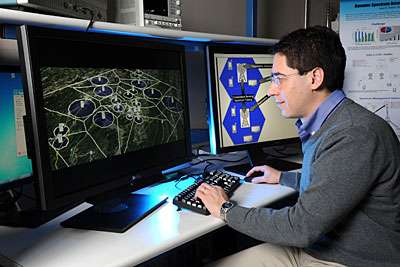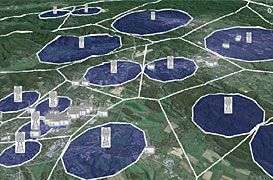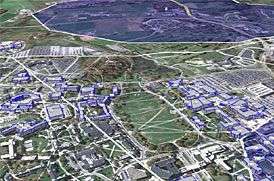INL researcher Dr. Juan Deaton developed a method to solve the approaching spectrum deficit by examining how cell networks could optimize spectrum use to get the most out of the existing range.
A new technology could help manage a potential data tsunami that might otherwise drastically restrict the use of smartphones, tablets and other wireless data technologies because of a nationwide mobile wireless broadband deficit.
The research was inspired because of a prediction by the Federal Communications Commission (FCC) that projects a spectrum shortage for broadband services in the near future. The approaching shortage is driven by a projected surge in mobile broadband traffic, which will likely overtake the ability for wireless networks to meet the demand.
Idaho National Laboratory researcher Dr. Juan Deaton has been working on a method that seeks to solve the approaching spectrum deficit by examining how cell networks could optimize spectrum use to get the most out of the existing range. Without optimizing spectrum use, the impacts of a spectrum deficit would extend from an individual level, like dropped calls and slow connections, to global economic consequences.
"It is estimated that connected life will account for $4.5 trillion globally in 2020," said Deaton. "But if we have only half the spectrum we need to conduct business like we are used to doing, it could negatively impact the U.S. economy by about $750 million."
Current spectrum use
Wireless spectrum, also called radio spectrum, is a limited resource. Measured in hertz (Hz), the highest valued radio spectrum exists between 700 megahertz (MHz) and 2,000 MHz (or 2 gigahertz). Within the radio spectrum, the wireless service providers, such as Verizon, have licensed a total 608 MHz of spectrum bandwidth for mobile wireless applications, explained Deaton. This doesn't include the other spectrum used for things like Wi-Fi.
Long Term Evolution (LTE) technology, also known as 4G, increases spectrum efficiency. But video streaming, smart grids and wireless home appliances cause the demand for data to skyrocket. The resulting spectrum demand is projected to grow fifteenfold in the next year.
"Although the technology migration to 4G technologies (LTE) will help support higher data rates, there is a physical limit of information that can go through a frequency channel," said Deaton. "The increased demand for data with the rise of smartphones, tablets and especially machine-to-machine communication will push us to that limit."
Deaton's wireless optimization method introduces a framework to help meet the demand for mobile wireless broadband and relieve the impending deficit. Because cell tower sites have different ranges and varying data rates, the number of people each site can service is limited. This can vastly influence how network users are able to access wireless broadband.
Deaton uses locations of real cell towers with population data to suggest the location of femto-cells to improve cell phone coverage.
A proposed solution
Based on the cellular traffic demand in a given area, Deaton's method assigns frequency channels (spectrum) to cell tower sites in order to best meet the demand for the largest amount of people.
"It is kind of like a complicated map-coloring problem," explained Deaton. "If you are creating a map of the U.S., but you can only use four different colors, what do you do when you have five states adjacent to each other?"
Similarly, each cell tower site is given a different frequency channel, and adjacent channels need to be different enough from one another to be usable.
Another way to imagine optimizing the spectrum is like solving a difficult Sudoku puzzle. The optimization process must be able to allocate frequency bands for cellular network traffic within appropriate places on a grid. Like a puzzle, the "rules" of Deaton's method say that the frequencies must be different numbers from each other, on the right place on a grid, and provide the highest wireless demands (numbers)—thus "solving" for an efficiently used spectrum.
Using Global Information System (GIS) data, Deaton's method incorporates population information, building footprints and cell tower sites to generate a network model. The method then shows optimal usage of spectrum in the network. By taking building footprints overlaid with population data, Deaton is able to discern both where the strongest demands are and where to put additional tiny cell towers, called femto-cells.
"Adding more cells together increases the bandwidth footprint and each individual will get more data per area," said Deaton. "The best way to optimize is to have multiple, small cell towers—then you can reuse frequencies more often."
On the Virginia Tech campus, Deaton’s method recommends how to assign spectrum channels to meet local bandwidth demand even within buildings.
The future of cellular networks
The research derived from Deaton's model points to the benefits of building multiple, smaller cell towers and sharing spectrum.
Despite the capabilities of the wireless optimization method, Deaton admits there are some limitations. First, putting up many tiny towers can be logistically difficult in urban areas where network companies need to work with building owners to construct more sites.
Second, the current mobile wireless broadband economy is not based on spectrum sharing, but rather on private ownership of spectrum bands. The current approach for licensing spectrum may limit new market entrants and new wireless services. Spectrum sharing could open the market to new services and the ability to optimize existing spectrum using Deaton's method.
This research is one of several projects at INL, along with the Wireless National Scientific User Facility, dedicated to innovation in spectrum, security and energy grid communications research. Deaton is now working on a spectrum server that could implement the optimization method when the spectrum saturates. The server would assign spectrum channels throughout the day to meet hourly demand. In short, the server could help cell towers make "decisions" based on where people need wireless spectrum.
Despite the projected spectrum deficit, Deaton remains optimistic about the future of wireless communication and its multilevel value in society.
"There is a close relationship between economic capability and telecommunications," he said. "The more tools you have to communicate, the more economic opportunities are available."
Provided by Idaho National Laboratory























